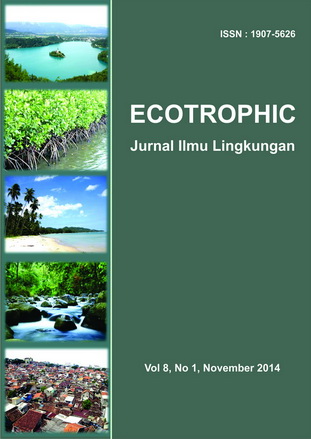ANALISIS VEGETASI MANGROVE UNTUK STRATEGI PENGELOLAAN EKOSISTEM BERKELANJUTAN DI TAMAN NASIONAL BALI BARAT
Abstract
This research was conducted in the coastal areas of Bali Barat National Park in March-June 2012. The goal is to determine the composition and structure of mangrove vegetation in Bali Barat National Park, the extent of damage and the level of criticality of mangroves in the area of ?? Bali Barat National Park and to determine management strategies for sustainable mangrove ecosystems in Bali Barat National Park. This study employed observation method with Line Transect sampling techniques and Sample Plots (Transect Line Plot) which is perpendicular to the shoreline landward. Data were analyzed using analysis of vegetation. Results showed mangrove vegetation in Bali Barat National Park consists 5 families major mangrove with 13 mangrove species and 5 families with 5 species of minor mangrove. In Gilimanuk Bay Important Value Index (IVI) for the highest phase of seedling was Excoecaria agallocha by 78.00%, sapling phase C. tagal amounted to 91.61% and the phase of the tree was Sonneratia alba by 103.76%. Shannon Diversity Index (H’) of mangrove vegetation in Gilimanuk Bay between 0.3630 to 0.7419 with a low category. In Terima Bay the highest IVI phase of seedling was Ceriops decandra by 78.33%, sapling phase C. decandra by 162.41% and the phase of tree was E. agallocha amounted to 85.06%. H’ mangrove vegetation in Terima Bay between 0.0000 to 0.7889 with a low category. In Banyuwedang Bay the highest IVI phase of seedling was E. agallocha by 63.08%, sapling phase was Ceriops tagal amounted to 86.28% and the phase of tree was E.agallocha of 79.98%. H’ mangrove vegetation in Banyuwedang Bay between 0.0000 to 0.7889 with a low category. In Menjangan Island the highest IVI phase of seedling was C. tagal by 63.69%, sapling phase C. tagal amounted to 66.66% and the phase of tree was E. agallocha by 109.08%. H’ Menjangan Island mangrove vegetation ranged from 0.3991 to 0.8217 with a low category. The level of damage based on Mangrove Damage Criteria according to Minister of Environment Decree No. 201 of 2004 seedlings and saplings phase, the density of each species included in the very dense criteria (good) and phase trees included in the rare criteria (damaged). The critical level of mangrove vegetation based on the formulation of the Directorate General of Land Rehabilitation and Social Forestry, Ministry of Forestry in 2005, mangrove vegetation in the Bali Barat National Park can be classified Not Damaged. Bali Barat National Park mangrove aquatic environment is conducive to support the stability and development of mangrove vegetation in the future as a result of physical and chemical parameter measurements mangrove aquatic environment is still below of standard.


